Announcing Oracle Cloud Compute E4 platform on third gen AMD EPYC processors
At Ora┬Łcle Open┬ŁWorld 2018, we announ┬Łced a stra┬Łte┬Łgic part┬Łner┬Łship with AMD and laun┬Łched the Ora┬Łcle E2 plat┬Łform on the first gene┬Łra┬Łti┬Łon of AMD EPYC pro┬Łces┬Łsors. Sin┬Łce that launch, weŌĆÖve deploy┬Łed Ora┬Łcle E2 Com┬Łpu┬Łte ins┬Łtances to all of our com┬Łmer┬Łcial regi┬Łons. Eigh┬Łte┬Łen months later, in April 2020, we built on this part┬Łner┬Łship and laun┬Łched the E3 plat┬Łform on the second gene┬Łra┬Łti┬Łon. Many of our enter┬Łpri┬Łse cus┬Łto┬Łmers and Ora┬Łcle Cloud appli┬Łca┬Łti┬Łons are run┬Łning gene┬Łral-pur┬Łpo┬Łse workloads on AMD EPYC pro┬Łces┬Łsors. Today, IŌĆÖm hap┬Łpy to announ┬Łce that Ora┬Łcle is laun┬Łching the E4 plat┬Łform based on third-gene┬Łra┬Łti┬Łon AMD EPYC pro┬Łces┬Łsors. The E4 plat┬Łform includes both bare metal and fle┬Łxi┬Łble vir┬Łtu┬Łal machi┬Łnes (VMs).
The┬Łse E4 stan┬Łdard ins┬Łtances use 64 core pro┬Łces┬Łsors, with a base clock fre┬Łquen┬Łcy of 2.55 GHz and a max boost of up to 3.5 GHz. The bare metal E4 stan┬Łdard Com┬Łpu┬Łte ins┬Łtance sup┬Łports 128 OCPUs (128 cores and 256 threads) with 256 MB of L3 cache, 2 TB of RAM, and 100 Gbps of over┬Łall net┬Łwork band┬Łwidth. This con┬Łfi┬Łgu┬Łra┬Łti┬Łon is the hig┬Łhest core count for a bare metal ins┬Łtance on any public cloud. The memo┬Łry band┬Łwidth is well sui┬Łted for both gene┬Łral-pur┬Łpo┬Łse and high-band┬Łwidth workloads that requi┬Łre lar┬Łger and fas┬Łter memory.
As demons┬Łtra┬Łted in the fol┬Łlo┬Łwing per┬Łfor┬Łmance bench┬Łmarks, the E4 Stan┬Łdard ins┬Łtances deli┬Łver up to a 15% increase in inte┬Łger per┬Łfor┬Łmance, a 21% increase in floa┬Łting point per┬Łfor┬Łmance, and a 24% increase in java per┬Łfor┬Łmance, com┬Łpared to E3 Stan┬Łdard ins┬Łtances. Also, the E4 ins┬Łtances pro┬Łvi┬Łde three times the pri┬Łce per┬Łfor┬Łmance rela┬Łti┬Łve to other gene┬Łral-pur┬Łpo┬Łse ins┬Łtances offe┬Łred by other cloud providers.
New pro┬Łces┬Łsors, bet┬Łter per┬Łfor┬Łmance, and the same pri┬Łce as E3 Com┬Łpu┬Łte ins┬Łtances, com┬Łbi┬Łned with our fle┬Łxi┬Łble Com┬Łpu┬Łte approach, which enables you to gra┬Łnu┬Łlar┬Łly cus┬Łto┬Łmi┬Łze the core counts and memo┬Łry of VMs, pro┬Łvi┬Łde bet┬Łter value.
Many enter┬Łpri┬Łse cus┬Łto┬Łmers for Ora┬Łcle appli┬Łca┬Łti┬Łons and gene┬Łral-pur┬Łpo┬Łse workloads have adopted our AMD EPYC pro┬Łces┬Łsor-based Com┬Łpu┬Łte ins┬Łtances. Our cus┬Łto┬Łmers have alre┬Ła┬Łdy suc┬Łcessful┬Łly deploy┬Łed AMD-based ins┬Łtances, inclu┬Łding the fol┬Łlo┬Łwing use cases:
-
Video con┬Łfe┬Łren┬Łcing
-
Real-time video processing
-
Mas┬Łsi┬Łve┬Łly par┬Łal┬Łlel pro┬Łces┬Łsing and high-per┬Łfor┬Łmance com┬Łpu┬Łting (HPC)
-
Busi┬Łness-cri┬Łti┬Łcal applications
-
Web and appli┬Łca┬Łti┬Łon servers
-
Backend ser┬Łvers for enter┬Łpri┬Łse applications
-
Gam┬Łing servers
-
In-memo┬Łry database
-
Caching fleets
-
App deve┬Łlo┬Łp┬Łment environments
Ora┬Łcle cus┬Łto┬Łmer Xact┬Łly, the lea┬Łder in reve┬Łnue intel┬Łli┬Łgence solu┬Łti┬Łons, uses OracleŌĆÖs AMD EPYC pro┬Łces┬Łsor-based Compute.
ŌĆ£Ora┬Łcle Cloud Infra┬Łstruc┬Łtu┬Łre (OCI) is uni┬Łque in pro┬Łvi┬Łding cus┬Łto┬Łmers with the gra┬Łnu┬Łla┬Łri┬Łty and fle┬Łxi┬Łbi┬Łli┬Łty in com┬Łpu┬Łte resour┬Łces,ŌĆØ said Ron Ras┬Łmus┬Łsen, CTO of Xact┬Łly. ŌĆ£Xact┬Łly has seen gre┬Łat, mea┬Łsu┬Łred bene┬Łfits from deploy┬Łing E3 in ope┬Łra┬Łting our mul┬Łti-ten┬Łant SaaS reve┬Łnue intel┬Łli┬Łgence solu┬Łti┬Łons. Our mul┬Łti┬Łten┬Łant SaaS solu┬Łti┬Łon is built on Java tech┬Łno┬Łlo┬Łgy, and we look for┬Łward to exten┬Łding the addi┬Łtio┬Łnal bene┬Łfits of E4 to our cus┬Łto┬Łmers in the near future.ŌĆØ
Key highlights
E4 ins┬Łtances con┬Łti┬Łnue the fle┬Łxi┬Łble infra┬Łstruc┬Łtu┬Łre approach that we estab┬Łlished with E3. YouŌĆÖre free to sel┬Łect the exact num┬Łber of OCPUs and amount of memo┬Łry that you need for a VM, not forced to choo┬Łse from a fixed menu of 1, 2, 4, 8, or 16. You can launch any cus┬Łtom VM size that meets your needs, such as a 3ŌĆæcore, 6ŌĆæcore, or 63-core VM with any┬Łwhe┬Łre from 1 GBŌĆō1 TB of memory.
The┬Łse cus┬Łtom sizes mean lower cos┬Łts. E4 ins┬Łtances bill sepa┬Łra┬Łte┬Łly for the OCPU and memo┬Łry resour┬Łces pro┬Łvi┬Łsio┬Łned. Each OCPU comes with its asso┬Łcia┬Łted simul┬Łta┬Łneous mul┬Łti┬Łth┬Łre┬Ła┬Łding unit and is pri┬Łced at US$0.025, and memo┬Łry is pri┬Łced at US$0.0015 per GBŌĆöthe same pri┬Łces as our E3 Com┬Łpu┬Łte ins┬Łtances. An E4 ins┬Łtance with 1ŌĆæOCPU ins┬Łtance and 16 GB of RAM has a pri┬Łce of US$0.049, which is 23% less than X7 Stan┬Łdard and 57ŌĆō61% less than com┬Łpa┬Łra┬Łble ins┬Łtances offe┬Łred by other clouds.
E4 ins┬Łtances sup┬Łport reboot resi┬Łze, so you can easi┬Łly migra┬Łte from your exis┬Łting com┬Łpu┬Łte ins┬Łtances to an E4 ins┬Łtance of com┬Łpa┬Łti┬Łble shape.
Instance availability
Table 1 shows the VM and the bare metal ins┬Łtances that are available at launch. The┬Łse ins┬Łtances are available in the fol┬Łlo┬Łwing regi┬Łons, with plans to have ins┬Łtances wide┬Łly available in all com┬Łmer┬Łcial regi┬Łons in the future:
-
US East (Ashb┬Łurn)
-
US West (Phoe┬Łnix)
-
India west (Mum┬Łbai)
-
Switz┬Łer┬Łland North (Zurich)
-
Bra┬Łzil East (Sao Paulo)
-
Cana┬Łda Sou┬Łthe┬Łast (Mont┬Łre┬Łal)
-
Aus┬Łtra┬Łlia sou┬Łthe┬Łast (Mel┬Łbourne)
-
Cana┬Łda Sou┬Łthe┬Łast (Toron┬Łto)
Table 1: E4 ins┬Łtances available at launch
| Ins┬Łtance | OCPU | Memo┬Łry | Extra sto┬Łrage | Net┬Łwork |
| BM.Standard.E4.128 | 128 | 2,048 GB | Up to 1 PB of remo┬Łte block storage | 100 Gbps |
| VM.Standard.E4.Flex | 1ŌĆō64 | 1ŌĆō64 GB per OCPU up to 1024 GB | Up to 1 PB of remo┬Łte block storage | 1 Gbps per OCPU |
OCPU refers to a sin┬Łgle core and its asso┬Łcia┬Łted thread. We pro┬Łvi┬Łde 1 Gbps per OCPU, up to a maxi┬Łmum of 40 Gbps.
Performance
We com┬Łpared the AMD EPYC CPU-based ins┬Łtances to our cur┬Łrent x86 stan┬Łdard alter┬Łna┬Łti┬Łves. Table 2 shows detail┬Łed configurations.
Table 2: Com┬Łpu┬Łte con┬Łfi┬Łgu┬Łra┬Łti┬Łons for per┬Łfor┬Łmance tests
| Sys┬Łtem Configuration | X7 Sys┬Łtem | E3 Sys┬Łtem | E4 Sys┬Łtem |
| CPU | Two x86 pro┬Łces┬Łsors, 26 cores per socket @ 2.0 GHz | Two AMD EPYC 7742, 64 cores per socket @ 2.25 GHz Base, and @3.4G Turbo | Two AMD EPYC 7J13, 64 cores per socket @ 2.55 GHz Base, and @3.5G Turbo |
| Memo┬Łry | 786 GB DDR4 | 2,048 GB DDR4 | 2,048 GB DDR4 |
| Net┬Łwork | Two 25 Gbps | Two 50 Gbps | Two 50 Gbps |
We ran per┬Łfor┬Łmance tests to exer┬Łcise the CPU per┬Łfor┬Łmance, floa┬Łting point per┬Łfor┬Łmance, and memo┬Łry sub┬Łsys┬Łtem per┬Łfor┬Łmance (see Table 3). We ran tests on ven┬Łdor-recom┬Łmen┬Łded pro┬Łprie┬Łta┬Łry com┬Łpi┬Łlers and Ora┬Łcle Linux ope┬Łra┬Łting sys┬Łtems. We ran the tests seve┬Łral times and aver┬Ła┬Łged the results. All SPEC num┬Łbers are estimates.
Table 3: Per┬Łfor┬Łmance tests and bench┬Łmark targets
| Test | Bench┬Łmark target |
| SPE┬ŁCra┬Łte 2017 Integer | Inte┬Łger performance |
| SPE┬ŁCra┬Łte 2017 Floa┬Łting Point | Floa┬Łting point performance |
| STREAM Tri┬Ład | Memo┬Łry sub┬Łsys┬Łtem performance |
The fol┬Łlo┬Łwing graphs show how the AMD E4 ins┬Łtances com┬Łpared against our X7 and E3 Com┬Łpu┬Łte instances.
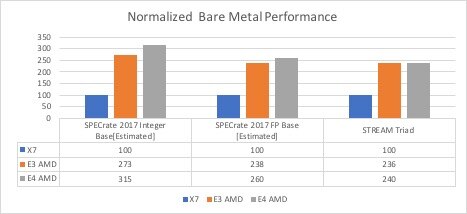
The third-gene┬Łra┬Łti┬Łon AMD EPYC pro┬Łces┬Łsor-based ser┬Łver per┬Łforms well com┬Łpared to our exis┬Łting port┬Łfo┬Łlio of bare metal Com┬Łpu┬Łte ins┬Łtances. The E4 Stan┬Łdard ins┬Łtances deli┬Łver up to a 15% increase in inte┬Łger per┬Łfor┬Łmance and a 9% increase in floa┬Łting point per┬Łfor┬Łmance com┬Łpared to the E3 ins┬Łtances. Com┬Łpared to the X7 stan┬Łdard ins┬Łtance, the E4 ins┬Łtance deli┬Łvers a 215% increase in inte┬Łger per┬Łfor┬Łmance, a 160% increase in floa┬Łting point per┬Łfor┬Łmance, and a 140% increase in STREAM Tri┬Ład bandwidth.
Figu┬Łre 2 shows the results of the bench┬Łmarks on VMs. All the tests were run on 2ŌĆæcore VMs.
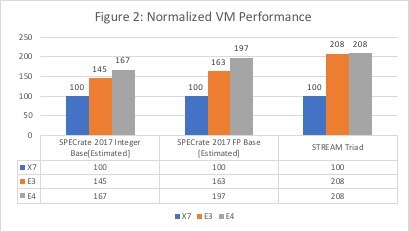
The ser┬Łver also per┬Łforms well com┬Łpared to our exis┬Łting VM ins┬Łtances on this set of stan┬Łdar┬Łdi┬Łzed bench┬Łmarks. The E4 stan┬Łdard ins┬Łtances deli┬Łver┬Łed a 15% impro┬Łve┬Łment in inte┬Łger per┬Łfor┬Łmance per core and 21% impro┬Łve┬Łment in floa┬Łting point per┬Łfor┬Łmance per core com┬Łpared to E3 based ins┬Łtances. More nota┬Łble is the com┬Łpa┬Łri┬Łson against X7 ins┬Łtances. The E4 stan┬Łdard ins┬Łtances deli┬Łver┬Łed a 67% impro┬Łve┬Łment in inte┬Łger per┬Łfor┬Łmance, 97% impro┬Łve┬Łment in Floa┬Łting point per┬Łfor┬Łmance, and a 108% increase in memo┬Łry per┬Łfor┬Łmance over an X7 instance.
Java benchmarks
Apart from the stan┬Łdar┬Łdi┬Łzed bench┬Łmarks, we also ran our inter┬Łnal Java bench┬Łmark to mea┬Łsu┬Łre ser┬Łver-side Java per┬Łfor┬Łmance. We ran the Java tests with an empha┬Łsis on the midd┬Łle-tier per┬Łfor┬Łmance. We ran the tests seve┬Łral times and aver┬Ła┬Łged the results.
Table 4: Java per┬Łfor┬Łmance test and bench┬Łmark target
| Test | Bench┬Łmark target |
| Ser┬Łver-Side Java Benchmark | Midd┬Łle-tier performance |
Figu┬Łre 3 shows the results of run┬Łning the Java bench┬Łmark tests on X7, E3, and E4 bare metal instances.
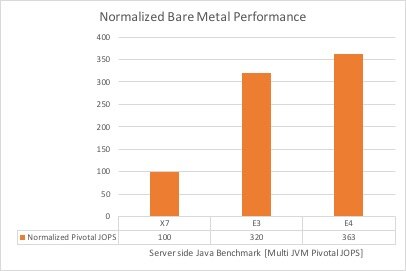
The E4 Stan┬Łdard ins┬Łtance deli┬Łver┬Łed a 13% increase in Java per┬Łfor┬Łmance com┬Łpared to E3 ins┬Łtances and a 263% increase com┬Łpared to X7 instances.
Figu┬Łre 4 shows the results of run┬Łning the Java bench┬Łmark tests on VMs. All the Java tests were run on 8ŌĆæcore VMs becau┬Łse of mini┬Łmum memo┬Łry requirements.
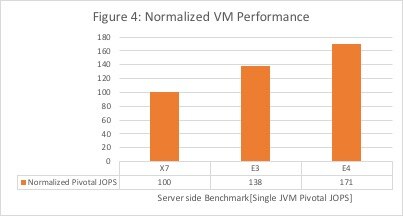
The E4 VM ins┬Łtances deli┬Łver┬Łed a 24% increase in Java per┬Łfor┬Łmance com┬Łpared to E3 and a 71% increase in Java per┬Łfor┬Łmance com┬Łpared to X7 instances.
Competitive benchmarks
We com┬Łpared our offe┬Łrings to whatŌĆÖs available from AWS. As shown in the fol┬Łlo┬Łwing gra┬Łphic, the E4 based ins┬Łtances out┬Łper┬Łfor┬Łmed the AWS ins┬Łtances in abso┬Łlu┬Łte per┬Łfor┬Łmance and pri┬Łce-per┬Łfor┬Łmance, with three times the pri┬Łce per┬Łfor┬Łmance of AWS ins┬Łtances across the┬Łse benchmarks.
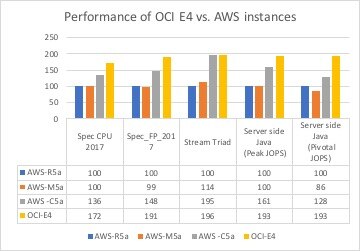
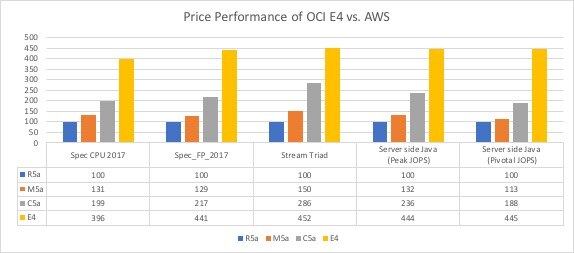
Conclusion
You can bene┬Łfit from this per┬Łfor┬Łmance by deploy┬Łing and migra┬Łting your workloads to the┬Łse Com┬Łpu┬Łte ins┬Łtances today. To learn more about AMD EPYC cloud solu┬Łti┬Łons for OCI, watch the video from our VP Ross Brown. For more infor┬Łma┬Łti┬Łon on the E4 Stan┬Łdard and fle┬Łxi┬Łble ins┬Łtances, you can access our docu┬Łmen┬Łta┬Łti┬Łon. For more Ora┬Łcle Cloud Infra┬Łstruc┬Łtu┬Łre solu┬Łti┬Łons for AMD EPYC-powered Ora┬Łcle Cloud ins┬Łtances, you can visit the AMD tech docs and white paper libra┬Łry.
